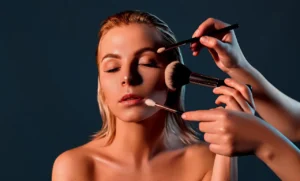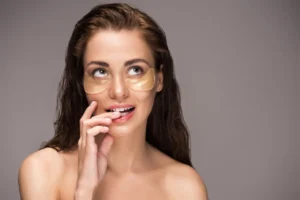Navigating the world of makeup can be daunting for beginners.
With a myriad of products and techniques, it’s easy to feel overwhelmed.
But fear not. This guide is here to help you understand the essential makeup techniques.
From creating a flawless base to defining your eyes and lips, we’ll walk you through each step.
You’ll learn practical beauty tips and hacks, and how to adapt these techniques for different occasions.
By the end of this guide, you’ll have the confidence to create a variety of makeup looks, enhancing your natural beauty.
Understanding Your Skin Type
Before diving into makeup application, it’s crucial to understand your skin type.
Knowing whether your skin is dry, oily, combination, or sensitive will guide your product choices. For instance, if you have oily skin, you might opt for oil-free, matte products. On the other hand, dry skin types may benefit from hydrating, dewy makeup.
Understanding your skin type is the first step towards achieving a flawless makeup look. It ensures that your makeup complements your skin, rather than working against it.
Step 1: Prepping Your Skin
A smooth canvas is key to a flawless makeup application. Start by cleansing your face to remove any dirt or oil.
Next, apply a moisturizer suitable for your skin type. This step hydrates your skin, making it ready for makeup. Remember, makeup sits better on well-moisturized skin.
Step 2: Primer – The Foundation’s Best Friend
Primer is a crucial step in makeup application. It creates a smooth surface for your foundation and helps it last longer.
Choose a primer that suits your skin type. For instance, if you have oily skin, opt for a mattifying primer. If your skin is dry, a hydrating primer would be a better choice.
Step 3: Foundation and Concealer Basics
Foundation is the canvas for your makeup artistry. It evens out your skin tone and provides a base for the rest of your makeup.
Choosing the right shade is crucial. Test a few shades on your jawline to find the perfect match. The right shade will blend seamlessly into your skin.
Concealer is your secret weapon against blemishes and under-eye circles. Apply it after your foundation to avoid wiping it away. Use a shade slightly lighter than your foundation for under-eye circles and a shade that matches your foundation for blemishes.
Remember, less is more. Start with a small amount and build up if needed. This will prevent your makeup from looking cakey.
Step 4: Setting Your Base
Setting your base is a key step in ensuring your makeup lasts all day. A light dusting of powder can help to set your foundation and concealer.
Choose a translucent powder for a natural look. Apply it with a large, fluffy brush for even distribution. Focus on areas where makeup tends to wear off first, like your T-zone. Remember, a little goes a long way.
Step 5: Defining the Eyes – Brows and Eyeshadow
Eyebrows frame your face and can dramatically change your look. Start by brushing your brows upwards with a spoolie. Then, fill in sparse areas with a brow pencil or powder.
Eyeshadow adds depth to your eyes. Start with a neutral base color all over your lid. Then, apply a darker shade in your crease for definition. Blend well to avoid harsh lines.
Remember, practice makes perfect. Don’t be discouraged if your eyeshadow doesn’t look perfect the first time. With time and patience, you’ll master these essential makeup techniques.
Step 6: Eyeliner and Mascara for Beginners
Eyeliner can be tricky for beginners, but it’s a game-changer. Start with a pencil liner as it’s easier to control. Draw a thin line along your upper lash line.
Mascara is the final touch to your eye makeup. It makes your eyes look wider and more awake. Start at the base of your lashes and wiggle the brush up to the tips.
Remember to be patient. It might take a few tries to get the hang of it. But once you do, it’ll be worth it.
Step 7: Contouring and Highlighting for Natural Definition
Contouring and highlighting can add depth and dimension to your face. Start with a contour shade that’s two shades darker than your skin tone. Apply it to the hollows of your cheeks, along your hairline, and down the sides of your nose.
Highlighting brings forward the high points of your face. Apply a highlighter to the tops of your cheeks, the bridge of your nose, and your cupid’s bow.
Remember, blending is key. You want to avoid harsh lines for a natural look.
Step 8: Blush – Adding a Healthy Glow
Blush gives your face a healthy, youthful glow. Apply it to the apples of your cheeks, blending upwards towards your temples.
Choose a blush color that complements your skin tone. Remember, less is more. You can always add more if needed.
Step 9: Lips – The Finishing Touch
Lip makeup can transform your look. Start by prepping your lips with a lip balm to ensure smooth application.
Next, outline your lips with a lip liner that matches your lipstick. Fill in your lips with lipstick, starting from the center and moving outwards. For a fuller look, add a touch of gloss in the center of your lips.
Makeup Tools and Maintenance
The right tools can make a big difference in your makeup application. Brushes, sponges, and other tools help you apply and blend products for a seamless look.
Remember to clean your tools regularly. This prevents buildup of product and bacteria, which can lead to skin irritation or infection.
Final Touches: Setting Spray and Makeup Longevity
To ensure your makeup lasts all day, a setting spray is a must. It locks in your makeup, preventing it from smudging or fading.
Remember, makeup is not just about application. It’s also about maintenance. Regular touch-ups throughout the day can help keep your makeup looking fresh and flawless.
Conclusion: Practice Makes Perfect
Mastering these essential makeup techniques may seem daunting at first. But remember, practice makes perfect.
With time, patience, and regular practice, you’ll soon be able to create flawless makeup looks with ease. So, keep experimenting and have fun with your makeup journey!


